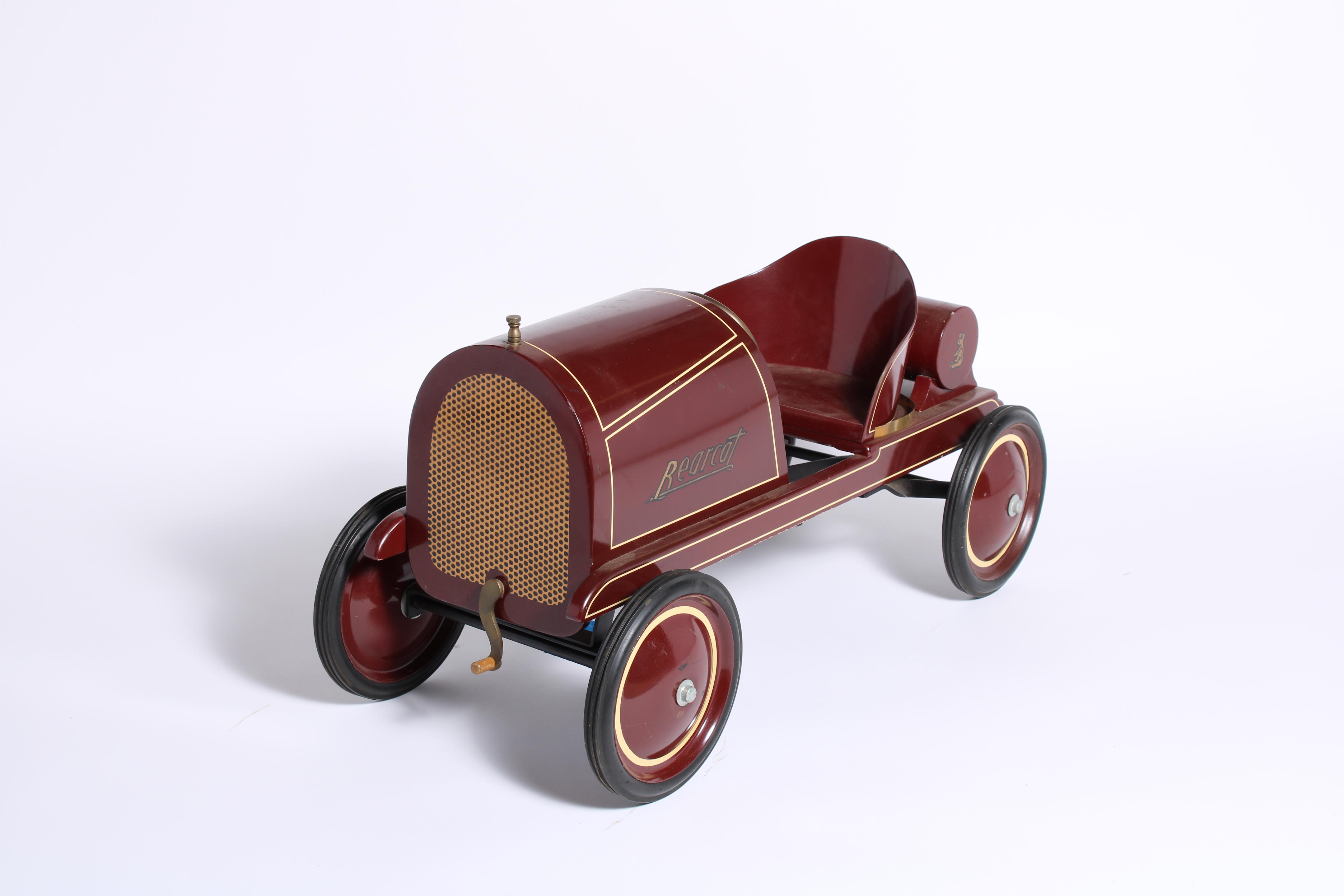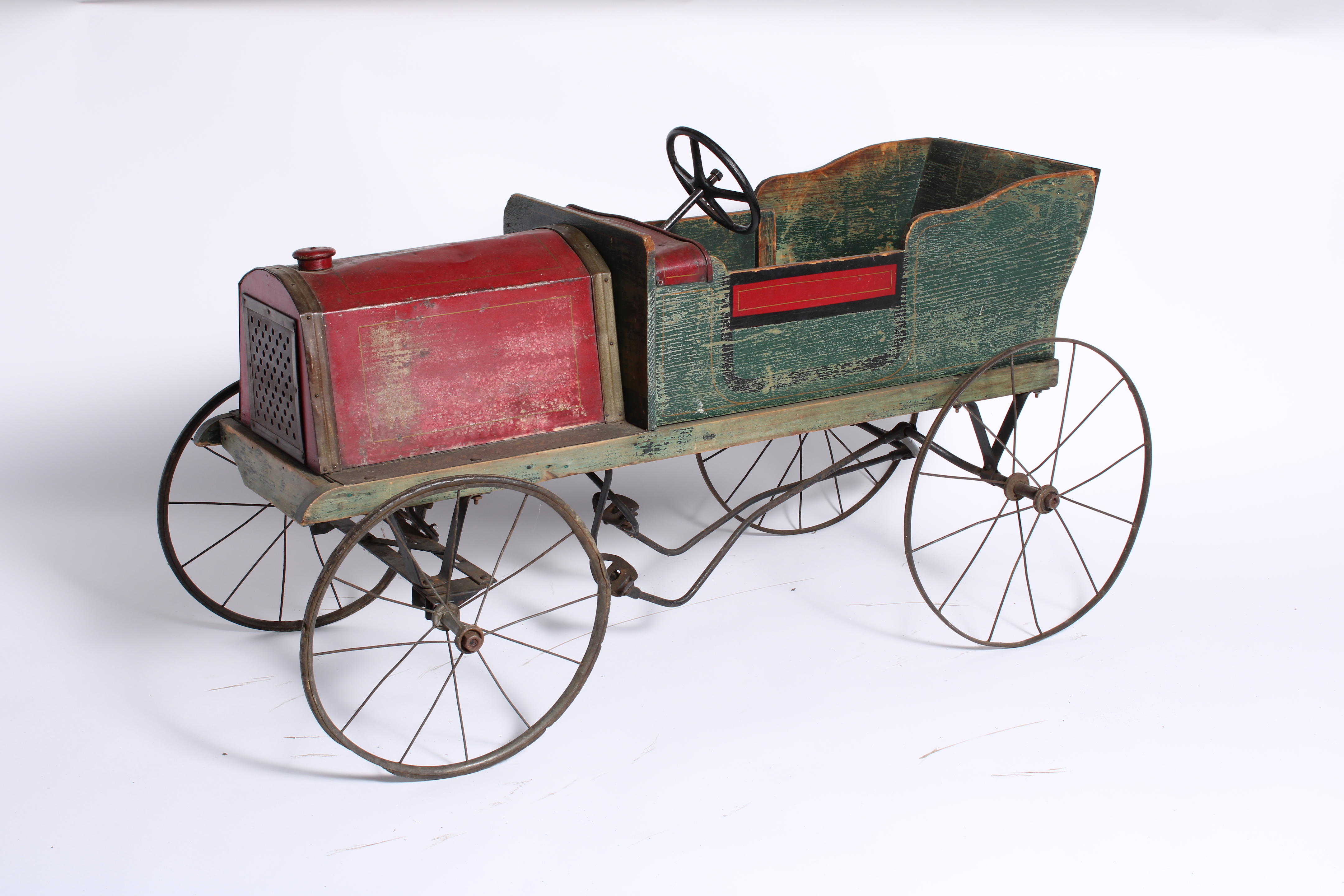143.1 ci, Pushrod Overhead Valve Inline 4-Cylinder Air-cooled Engine (likely 1909/10)
Single Carburetor
Approximately 22hp
3-Speed Manual Transmission
Fully Elliptic Leaf Suspension
2-Wheel Rear Drum and Transmission Brake
*Early 'barrel nose' Franklin touring car
*A way to experience Franklin's alterative approach to the automobile
*Formerly in long term California ownerships
THE FRANKLIN MODEL G
For the early part of the Franklin story please refer to Lot 512. After its debut with a transversely mounted four-cylinder in 1902, 1905 would prove to be a transitional year as the Franklin's engine moved up front under the barrel-shaped hood with a front-mounted fan to supply cooling air to the finned individual cylinders. Wilkinson was a fervent believer in the virtues of light weight and simplicity, a belief reflected in his decision to reject the added components and complexity of water cooling. He kept experimenting and adding features as soon as they demonstrated their practicality. Automatic spark advance was added in 1907, pressure feed lubrication in 1912, aluminum pistons in 1915, aluminum connecting rods in 1922.
At first glance this early Franklin looks like a conventional touring car of the day. Even its big round grille wasn't that out of place in 1910. Delaunay-Bellevilles sported similar grilles. Look a little closer, though, and some unusual things begin to become apparent. The Franklin had full-elliptical springs, for instance, which most marques had abandoned in favor of semi-elliptical and 3/4 elliptical springing that provided more accurate wheel and axle location. The Franklin's laminated wood frame was worthy of notice, too, at a time when such wood frames as survived were pretty generally at least steel "armored".
That was, however, about all that was apparent from outside. It was unusual, and maybe even a little archaic in the fast-moving automobile industry in the final year of the century's first decade. The big difference was that Franklin was doing all these things by design and with the intent of perfectly sound engineering principles. It would keep them, more or less, for the rest of its life and in the process build up a loyal following of customers who appreciated its determinably idiosyncratic insistence upon doing things Franklin's way.
More than a hundred years later no one has come up with a convincing argument why Franklin was wrong, either. The big round grille was Franklin's way of swallowing the volumes of air needed to satisfy its overhead valve four-cylinder engine's direct air cooling. "Direct" in the sense that all automobile engines are air cooled (unless they're suddenly dunked in a river or pond) using water or some other liquid concoction coolant as an intermediary.
The full-elliptical springs gave a soft, comfortable ride and were reputed to be easy on tires. The wood frame has been compared with a good tennis racquet or old time wooden skis which flex and absorb shocks and irregularities before they get to the human's frame. Franklin dealers would perversely jack up opposite corners of their cars, then demonstrate how the doors still opened and closed smoothly. Try that on a Buick or Ford.
The Model G was introduced in 1906 with a 12hp engine and 88" wheelbase. The model grew in following years, 12hp on 90" wheelbase in 1907, 16hp on 90" in 1908, and 18hp on 91 1/2" in 1909 and 1910 with 143 cubic inches displacement from a 3 3/8" bore and 4" stroke. The compact chassis dimensions are closely adapted to the attractive close-coupled four-place touring car coachwork which is so consistent with the philosophy of John Wilkinson. The engine drives through a 3-speed transmission and shaft drive with contracting band rear wheel brakes and a separate band brake on the driveshaft.
THE MOTORCAR OFFERED
The Model G we offer here dates from the 1908 season. There is nothing on file that charts its provenance, however consultation with respected marque authority Mark Chaplin has confirmed that while not owned by members of the Franklin fraternity its ownership over the last three decades can be traced back to a H. Maxwell of California from at least as far back as 1989 and up to 2015, and it appears to have been briefly owned by noted collector Jim Cooley of San Diego prior to its acquisition by the father and son Two Generations collection.
Mr. Chaplin also noted that the 1908 engines were the Achilles heel of that year's production and it was quite common for them to have been replaced with slightly later units, often by the factory. Distinctive features of the successors were concentric valve engines as well as magneto ignition, which its precisely what can be found in this car. It is most likely that the power unit dates from 1909 or 1910, although a number was not found to be visible to substantiate this.
On inspection, the Franklin while clearly complete and an honest entity, it is apparent that the car has been refurbished in a basic manner for aesthetic presentation, rather than on the technical side. The paintwork in a bottle green scheme appears to be relatively fresh as does the button back interior trim work.
All in all this is an interesting example of its breed and a perfect foil to its predecessor in the collection to demonstrate how the Franklin production developed. With mechanical refreshing, it could provide its next owner with a purposeful way to experience this unique automobile brand.
143.1 ci, Pushrod Overhead Valve Inline 4-Cylinder Air-cooled Engine (likely 1909/10)
Single Carburetor
Approximately 22hp
3-Speed Manual Transmission
Fully Elliptic Leaf Suspension
2-Wheel Rear Drum and Transmission Brake
*Early 'barrel nose' Franklin touring car
*A way to experience Franklin's alterative approach to the automobile
*Formerly in long term California ownerships
THE FRANKLIN MODEL G
For the early part of the Franklin story please refer to Lot 512. After its debut with a transversely mounted four-cylinder in 1902, 1905 would prove to be a transitional year as the Franklin's engine moved up front under the barrel-shaped hood with a front-mounted fan to supply cooling air to the finned individual cylinders. Wilkinson was a fervent believer in the virtues of light weight and simplicity, a belief reflected in his decision to reject the added components and complexity of water cooling. He kept experimenting and adding features as soon as they demonstrated their practicality. Automatic spark advance was added in 1907, pressure feed lubrication in 1912, aluminum pistons in 1915, aluminum connecting rods in 1922.
At first glance this early Franklin looks like a conventional touring car of the day. Even its big round grille wasn't that out of place in 1910. Delaunay-Bellevilles sported similar grilles. Look a little closer, though, and some unusual things begin to become apparent. The Franklin had full-elliptical springs, for instance, which most marques had abandoned in favor of semi-elliptical and 3/4 elliptical springing that provided more accurate wheel and axle location. The Franklin's laminated wood frame was worthy of notice, too, at a time when such wood frames as survived were pretty generally at least steel "armored".
That was, however, about all that was apparent from outside. It was unusual, and maybe even a little archaic in the fast-moving automobile industry in the final year of the century's first decade. The big difference was that Franklin was doing all these things by design and with the intent of perfectly sound engineering principles. It would keep them, more or less, for the rest of its life and in the process build up a loyal following of customers who appreciated its determinably idiosyncratic insistence upon doing things Franklin's way.
More than a hundred years later no one has come up with a convincing argument why Franklin was wrong, either. The big round grille was Franklin's way of swallowing the volumes of air needed to satisfy its overhead valve four-cylinder engine's direct air cooling. "Direct" in the sense that all automobile engines are air cooled (unless they're suddenly dunked in a river or pond) using water or some other liquid concoction coolant as an intermediary.
The full-elliptical springs gave a soft, comfortable ride and were reputed to be easy on tires. The wood frame has been compared with a good tennis racquet or old time wooden skis which flex and absorb shocks and irregularities before they get to the human's frame. Franklin dealers would perversely jack up opposite corners of their cars, then demonstrate how the doors still opened and closed smoothly. Try that on a Buick or Ford.
The Model G was introduced in 1906 with a 12hp engine and 88" wheelbase. The model grew in following years, 12hp on 90" wheelbase in 1907, 16hp on 90" in 1908, and 18hp on 91 1/2" in 1909 and 1910 with 143 cubic inches displacement from a 3 3/8" bore and 4" stroke. The compact chassis dimensions are closely adapted to the attractive close-coupled four-place touring car coachwork which is so consistent with the philosophy of John Wilkinson. The engine drives through a 3-speed transmission and shaft drive with contracting band rear wheel brakes and a separate band brake on the driveshaft.
THE MOTORCAR OFFERED
The Model G we offer here dates from the 1908 season. There is nothing on file that charts its provenance, however consultation with respected marque authority Mark Chaplin has confirmed that while not owned by members of the Franklin fraternity its ownership over the last three decades can be traced back to a H. Maxwell of California from at least as far back as 1989 and up to 2015, and it appears to have been briefly owned by noted collector Jim Cooley of San Diego prior to its acquisition by the father and son Two Generations collection.
Mr. Chaplin also noted that the 1908 engines were the Achilles heel of that year's production and it was quite common for them to have been replaced with slightly later units, often by the factory. Distinctive features of the successors were concentric valve engines as well as magneto ignition, which its precisely what can be found in this car. It is most likely that the power unit dates from 1909 or 1910, although a number was not found to be visible to substantiate this.
On inspection, the Franklin while clearly complete and an honest entity, it is apparent that the car has been refurbished in a basic manner for aesthetic presentation, rather than on the technical side. The paintwork in a bottle green scheme appears to be relatively fresh as does the button back interior trim work.
All in all this is an interesting example of its breed and a perfect foil to its predecessor in the collection to demonstrate how the Franklin production developed. With mechanical refreshing, it could provide its next owner with a purposeful way to experience this unique automobile brand.















Try LotSearch and its premium features for 7 days - without any costs!
Be notified automatically about new items in upcoming auctions.
Create an alert